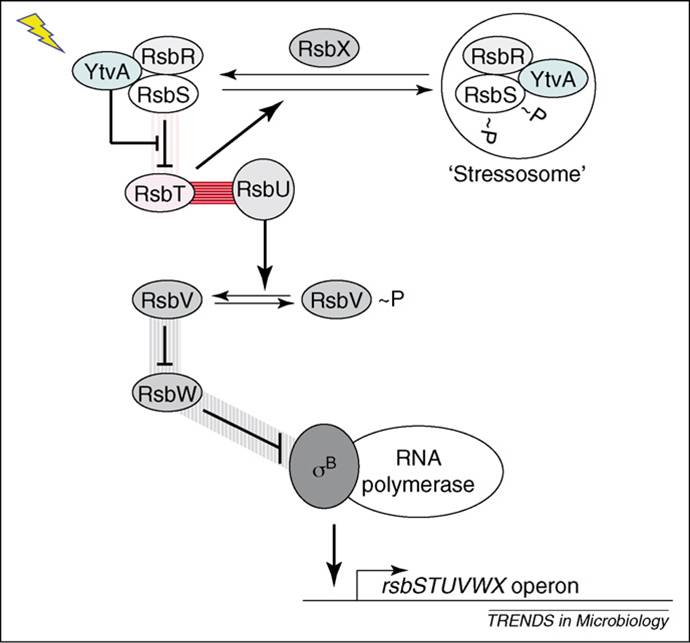Light Sensing
| YtvA
|
|
We have chosen light stimulus as our input for the Biofabricator. Light allows us to generate complex patterns with well defined edges, while gradients in wavelength and intensity will allow us to build up varying concentrations of biomaterial.
Photoreceptors and domains that were considered in our design include rhodopsins, phytochromes, LOV and BLUF. Of these, B. subtilis contains the blue light sensing protein YtvA which is related to the plant blue-light receptors phototropins. YtvA is a positive activator of the general stress transcription factor σB. Blue and not red light activates YtvA and thus induces σB activity. We could use σB which is expressed upon blue light illumination to activate the production of EpsE and hence control bacteria motility. However, there are other stressors which activate σB (detailed in the box below), hence we aim to make blue light the main activator of σB by controlling growth conditions and over expressing the YtvA receptor.
|

|
| Stress Response
|
|
One the of the first responses that gram positive bacteria have to stress is to synthesis the family of σB stress proteins. This σB is an alternative RNAP subunit that confers the ability to recognize a new series of promoters, particularly the SigB operon. If we wish to use the σB promoter within our device we need to understand all the potential inputs that σB can respond to.
To the right is an abstract diagram showing how the σB is activated. As can be seen in the diagram the pathway is dependent on the antagonist relationship between kinase and phosphatase. Essentially this is an elaboration of two component signaling found in many bacterium and simple eukaryotic, where there is sensing, transduction and transcriptional control.
The input of stress is at various points and can be generally split into nutrient and environment stress response.
Nutrient Response
RsbP is the node for nutrient stress response. In conditions of low ATP and GTP RsbP. It is not known exactly how the RsbP responds to the signals, RsbP contains a PAS motif that in some regulatory systems can respond directly to changes in electron transport, proton motive force, or redox potential, changes that typically precede shifts in high-energy nucleotide levels (7).
Environmental Response
The physical stress phosphatase (RsbU) requires a second protein (RsbT) for activity. Stress is thought to initiate a process that triggers the release of RsbT from a large inhibitory complex composed of multiple copies of two protein species, RsbR (and/or its paralogues) and RsbS. The stress-derived signal driving RsbT release is unknown, but it fails to develop in B. subtilis lacking either ribosome protein L11 or the ribosome-associated protein Obg. RsbR, RsbS, RsbT, Obg and ribosomes elute in common high-molecular-mass fractions during gel-filtration chromatography of crude B. subtilis extracts (8).
Go back to the >>> Specifications Page >>>
|
|
|
|
References
- Sabehi, G.; Loy, A.; Jung, K-H; Partha, R.; Spudich, J.L.; Isaacson, T.; Hirschberg, J.; Wagner, M. & Béjà, O. (2005) New Insights into Metabolic Properties of Marine Bacteria Encoding Proteorhodopsins - PLoS Biol 3(8) 273 ([http://biology.plosjournals.org/archive/1545-7885/3/8/pdf/10.1371_journal.pbio.0030273-p-L.pdf PDF])
- Walter, J.M.; Greenfield, D.; Bustamante, C. & Liphardt, J. (2007) Light-powering Escherichia coli with proteorhodopsin - Proc Natl Acad Sci 104(7) 2408-12 ([http://www.ncbi.nlm.nih.gov/pubmed/17277079 Pubmed])
- vila-Pérez, M.A.; Hellingwerf, K.J. & Kort, R. (2006) Blue Light Activates the σB -Dependent Stress Response of Bacillus subtilis via YtvA - Journal of Bacteriology 188(17) 6411-6414 ([http://jb.asm.org/cgi/content/abstract/188/17/6411 Link])
- Losi, A.; Polverini, E.; Quest, B. & Gärtner, W. (2002) First Evidence for Phototropin-Related Blue-Light Receptors in Prokaryotes. - Biophys. J. 82(5) 2627-2634 ([http://www.biophysj.org/cgi/content/abstract/82/5/2627 Link])
- Losi, A.; Quest, B. & Gärtner, W. (2003) Listening to the blue: the time-resolved thermodynamics of the bacterial blue-light receptor YtvA and its isolated LOV domain - Photochem. Photobiol. Sci. 2 759-766 ([http://www.rsc.org/Publishing/Journals/PP/article.asp?doi=b301782f Link])
- van der Horst, M.A.; Key, J. & Hellingwerf, K.J. (2007) Photosensing in chemotrophic, non-phototrophic bacteria: Let there be light sensing too - Trends in Microbiology 15(12) 554-562 ([http://www.sciencedirect.com/science?_ob=MImg&_imagekey=B6TD0-4R5G81C-2-1&_cdi=5184&_user=217827&_orig=search&_coverDate=12%2F31%2F2007&_sk=999849987&view=c&wchp=dGLzVlz-zSkWb&md5=3e1fb96f1e3c38c41b123a2bb89b3878&ie=/sdarticle.pdf PDF])
- Zhang, S. & Haldenwang, W.G. (2005) Contributions of ATP, GTP, and redox state to nutritional stress activation of the Bacillus subtilis sigmaB transcription factor - J. Bacteriol. 187(22) 7554-60 ([http://www.ncbi.nlm.nih.gov/pubmed/16267279 PubMed])
- Kuo, S.; Zhang, S.; Woodbury, R.L. & Haldenwang, W.G. (2004) Associations between Bacillus subtilis sigmaB regulators in cell extracts - Microbiology 150(Pt 12) 4125-36 ([http://www.ncbi.nlm.nih.gov/pubmed/15583165 PubMed])
|
|
|